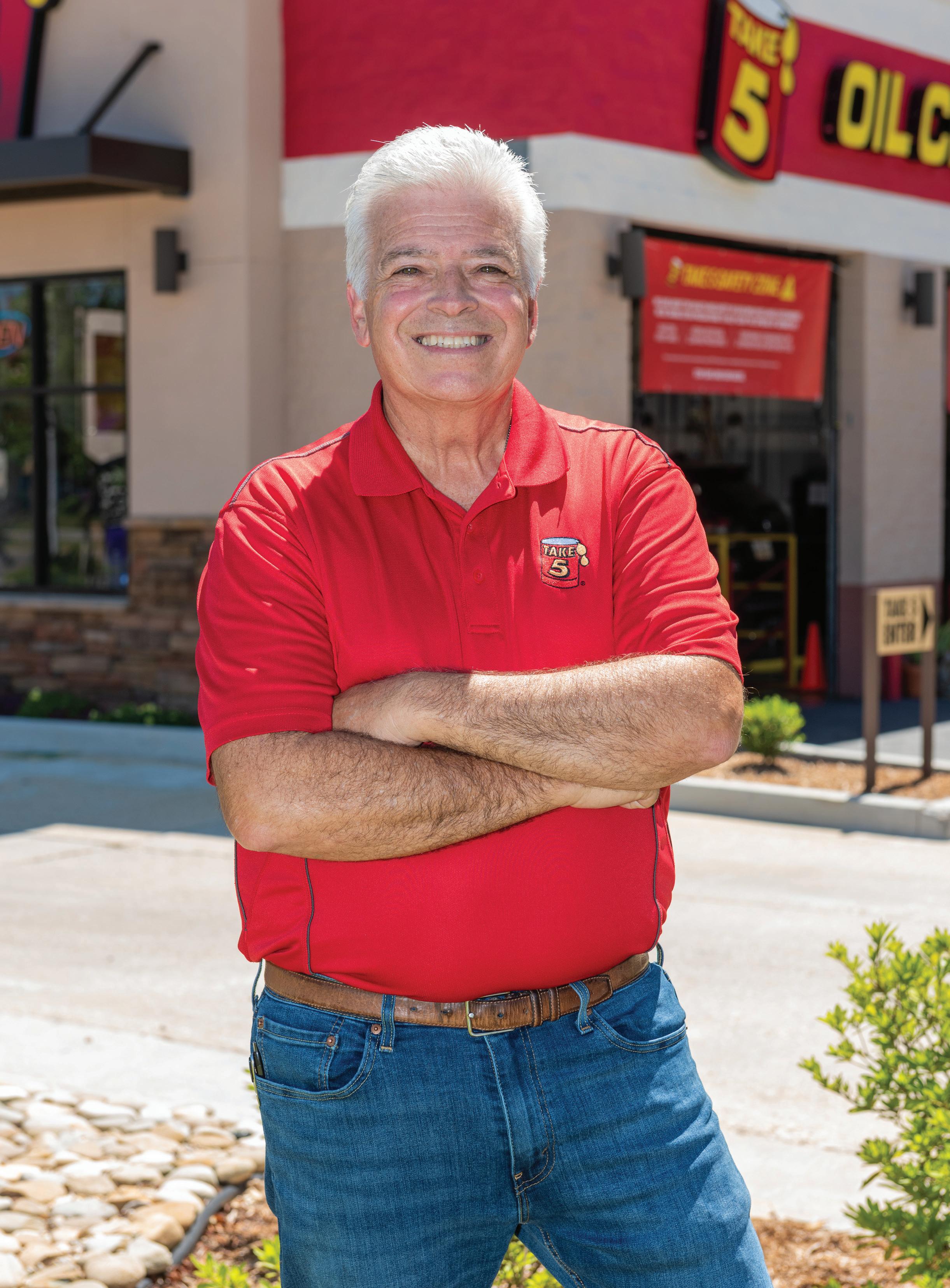
15 minute read
CASE STUDY

from NOLN - July 2020
by EndeavorBusinessMedia-VehicleRepairGroup
irst impressions are everything, as they say. While not all quick lubes have a waiting room, many are starting to evolve their models to provide more full-service options. And with this requires more time spent at a quick lube shop.
Take Quality Tune Up, for example. The quick lube operation started off as a go-to for oil changes, tune ups, and smog checks. But as time went on, the company evolved into a full-service operation, adding brake, transmission, and many other maintenance services to its menu. Now, it can take an hour or two before a car gets done, according to Tom McVey, franchiser of six Quality Tune Up’s in the Sacramento, Calif., area. And because of that, it’s up to the shop to make that time an effectively positive experience.
“A waiting room is more important for this kind of shop,” McVey says.
Here’s how McVey created a waiting room that customers enjoy and how it’s helped retain more and more customers.
The Challenge When McVey took over Quality Tune Up’s Sacramento, Calif., operations as the main franchiser, he was walking into a full “Fixer Upper”-type situation (Chip and Joanna Gaines, anyone?). To put it into perspective, he says most of the shops were built in the 1950s, and it definitely showed on each location’s curb appeal. The past owners hadn’t bothered to update it, even when the company evolved into a more full-service operation back in 1996.
McVey knew all of his shop’s needed a major facelift. He wanted to streamline a clean look across all locations, provide a comfortable, relaxing environment while customers wait, and make it that way so customers will want to come back again and again.
The Solutions
Allocating Resources
McVey hit the ground running. With the help of an advertising group he worked with at the time, he picked the color scheme and hired out a contractor to carry out the work. In order to make each location the same, different jobs were required to achieve that look. Some businesses just needed an updated paint job, while others had walls torn down for more open space. McVey says, luckily, his contractor was willing to work after hours, starting around 5 or 6 p.m. until midnight, which led to no disruption in regular business with bigger projects.
But McVey didn’t remodel all of the locations at once. Each month, the shop
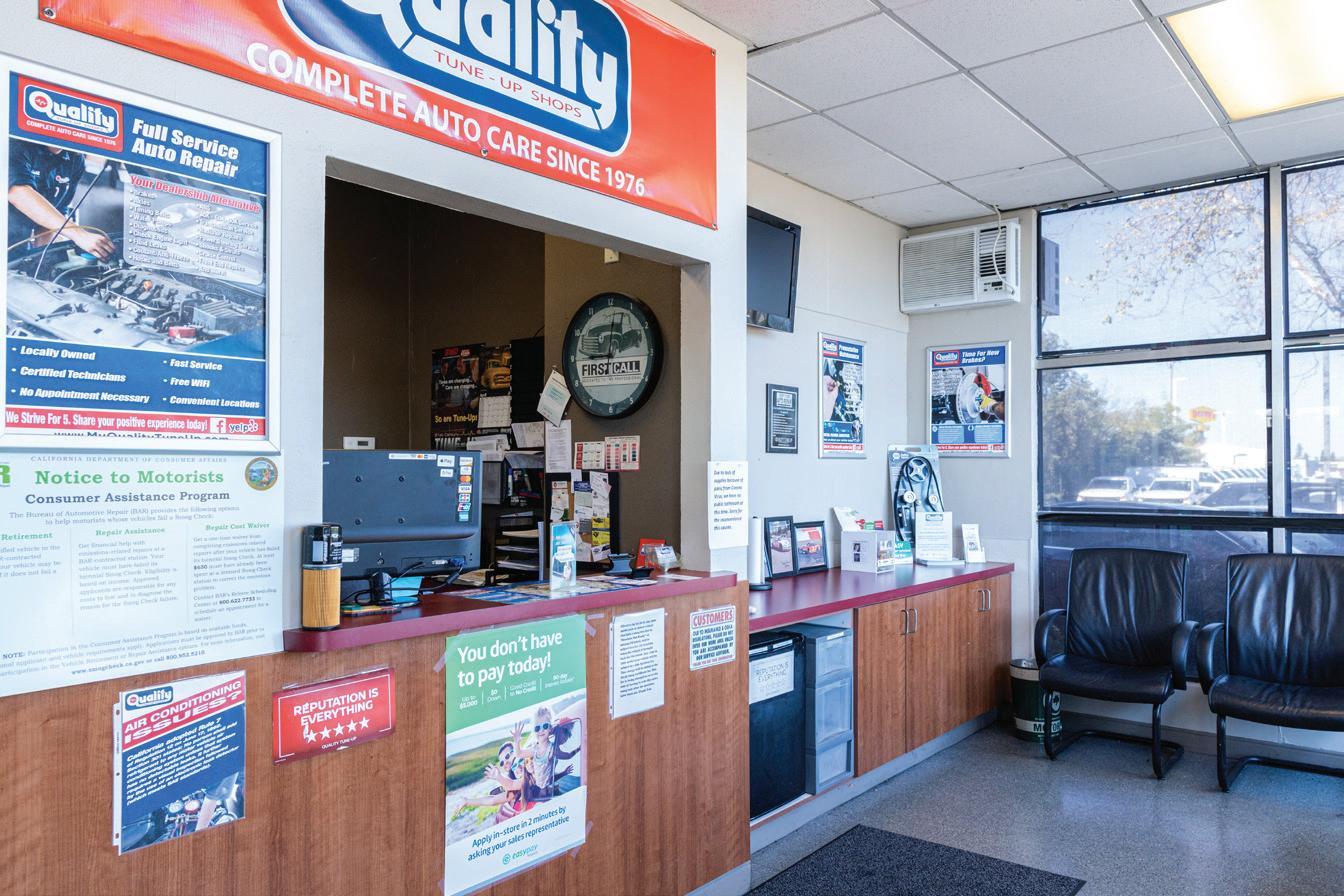
had an advertising budget toward its marketing efforts. When there was extra room in the budget, he’d put the money toward the waiting rooms.
“Whenever there’s extra money left over, I use it to enhance the shop,” McVey says. “As we had some advertising money, we would do another location.”
So while the total investment for remodeling all the locations was between $15,000 and $20,000, McVey was able to remodel all of his waiting rooms without breaking the bank.
Providing Entertaining Amenities
Since the quick lube’s updated services have added more time to a customer’s wait, having a comfortable waiting room was important to McVey.
Like other industry waiting rooms, having comfortable seating is number one on the list. McVey replaced the worn-out furniture with black, leather chairs that look clean and provide a comfortable oasis to relax (and are easy to wipe off, too). He also installed TVs and added WiFi to all of his locations to provide some entertainment while they wait in all of his waiting rooms.
As the main franchisor in the Sacramento area, McVey franchises two of the locations, while franchisees under him operate the four other locations. He leaves it up to his franchisees on how far on ‘the extra mile’ scale they want to
—Tom McVey, owner, Quality Tune Up of Sacramento, Calif.
go in customer service, but, personally, he wanted to provide a little more. He added a coffee station to fuel their day, a refrigerator that’s filled with water, soda, and other drinks, and snacks for guests to munch on.
On average, McVey spends about $250 per month to restock the items vs. having a soda machine that customers pay for. He says it’s worth every penny to
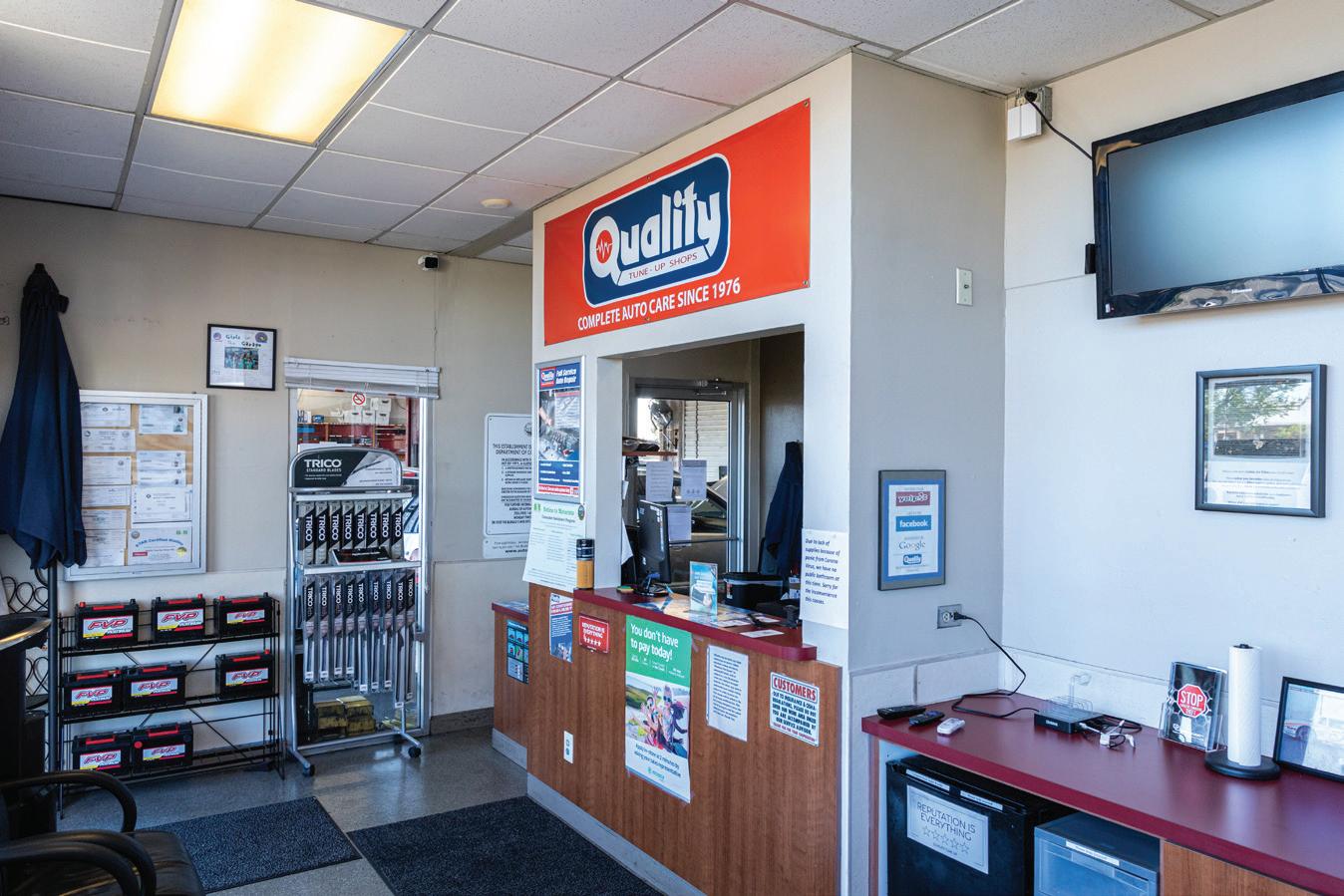
keep customers happy, and helps him stand out from other shops.
“It’s not something you get in most other waiting rooms,” McVey says.
An extra bonus: at one of his stores, there’s an extended waiting room that leads outside where customers can sit at either a round table with an umbrella or a spacious bench and enjoy the fresh air. Someday, McVey would like to add an outside section to all of his locations.
The Aftermath After McVey updated all of the locations, he noticed a difference; not only in the overall appearance of the shop, but on the customer’s faces. The appearance of the waiting room was warm, inviting, and comfortable to be in, and the amenities added even more to the experience.
McVey says the most important number to him is retention. Since the updates, the shop has seen a 70 percent retention rate—compared to 57 percent in 2011 at the Rancho Cordova, Calif. store specifically—and it’s not just because he slapped a new paint color on the walls and threw a bag of chips into the mix.
Take a Seat At these Quality Tune Up franchise shops, guest seating is one item that must live up to the brand name. Tom McVey says that he springs for premium chairs in the waiting room. QUALITY TUNE UP
OPERATOR: TOM MCVEY
LOCATION: 6 IN SACRAMENTOAREA
AVERAGE STAFF SIZE: 5-6
AVERAGE SHOP SIZE: 1,400 SQUARE FEET
AVERAGE NUMBER OF BAYS: 3
AVERAGE DAILY CAR COUNT: 20
TICKET AVERAGE: $150
To put it into perspective, Quality Tune Up has always had a front desk in its waiting rooms with an employee always behind the front desk, answering phones and assisting customers. With the updates providing a more comfortable, relaxing vibe, customers are more likely to stay and wait. And the more time a customer is hanging out in the waiting room, the more likely it is for employees to build better customer relationships.
“The biggest benefit is [customers] want to hang out in there,” McVey says. “It gives an opportunity for staff to talk to them and get to know them better.”
The Takeaway With some shops having drive-thru, 10-minute services, it can be hard to build on to a customer relationship. For shops that offer more services that make a customer’s trip more like an hour or two, it’s important for them to make a more lasting impression. McVey’s overall goal was to provide a place for customers to relax, and in doing so, it gave the shop a better chance to build onto its customer relationships.
TPMS and Servicing Liability
Best practices for limiting exposure
Tire Pressure Monitoring Systems (TPMS) have been required systems on new passenger vehicles since late 2007. But still many shop owners remain unsure of their liability when servicing these systems and what the best method is to mitigate its exposure and ensure the safety of their customers’ vehicles.
Establish a standard operating procedure, educate your staff, and develop a partnership with a trusted tool and parts manufacturer. These are the keys to limiting a shop’s exposure and providing quality service for every successful repair shop, regardless of specialty, but especially when servicing TPMS.
It was the TREAD act, passed in 2000, that mandated TPMS on new vehicles. But the law most prevalent to repair shops is the Motor Vehicle Safety Act of 1966 and provision (49 USC 30122(b)) that forbids them from “knowingly making inoperative, in whole or in part, any part of a device or element of design installed on or in a motor vehicle in compliance with an applicable motor vehicle safety standard."
Where TPMS is concerned, this provision mandates repair shops cannot disable the system or the malfunction light, but also, must ensure that if the system was working when the vehicle came into the shop, it must be working when the vehicle is released to the customer. Failure to meet this provision can result in a shop receiving a civil penalty of up to $6,000 for each violation.
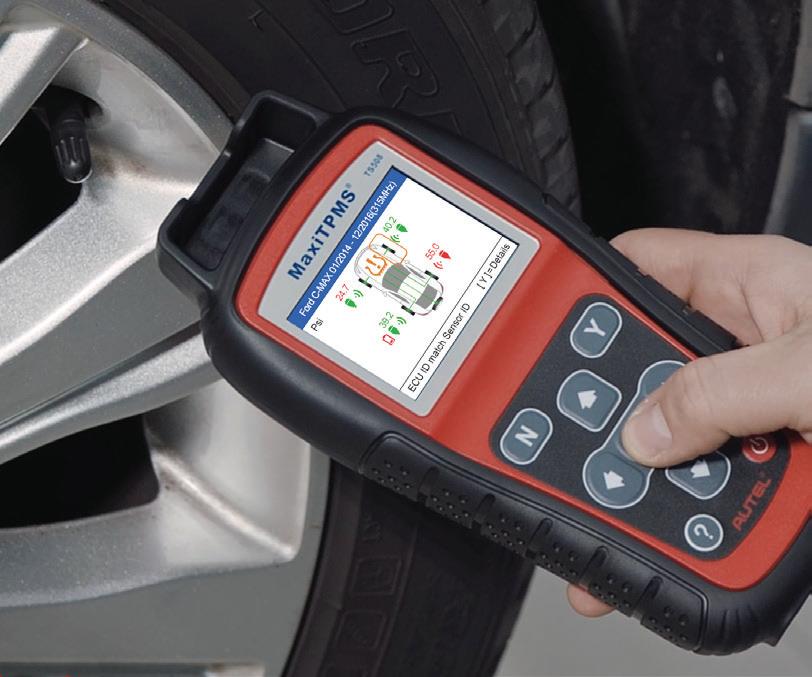
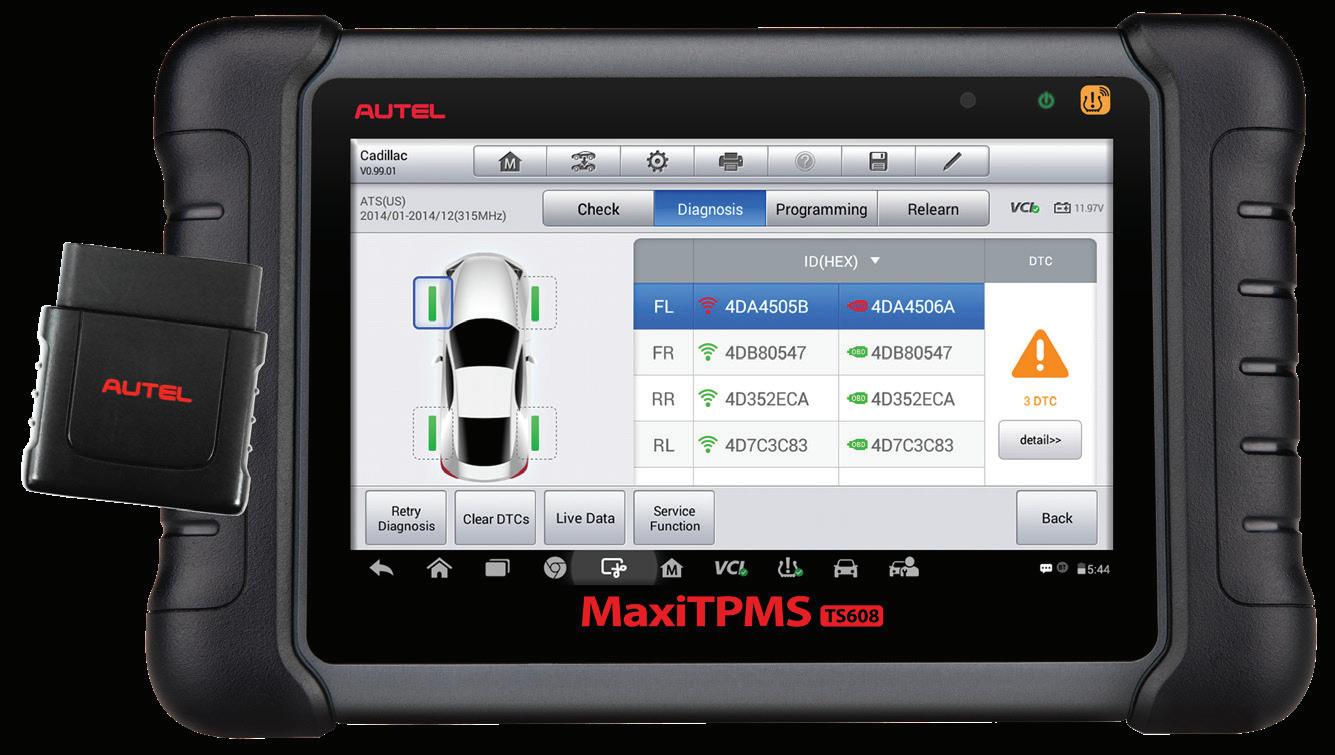
The Process The first key to ensuring your shop is following provisions and ensuring safety, is to develop a standard operating procedure (SOP). When developing the business SOP, the first step must include a conversation with the customer regarding the status of the system and a test of the sensors and TPMS module itself, prior to any service on tire or rim.
The next step in a proper SOP is to check each wheel sensor with a proper TPMS tool that can activate the sensor. Autel offers a line of TPMS tools that can activate and read all known TPMS sensors, including displaying the battery condition of the sensor.
In addition to battery life, the elements also take a toll on sensors, particularly aluminum stems that often fall prey to corrosion on the outside or inside the stem. Test these next. Autel’s MaxiTPMS TS508 handheld and the TS608 Android tablet guide the user through the test, step by step.
Once the sensors are tested, the technician plugs the tool into the OBDII port and performs a quick status check on the TPMS module. A color-coded system status screen displays, identifying at-a-glance if the sensors are good, if the IDs were improperly registered or relearned to the vehicle, perhaps during a recent tire rotation, or if the fault lies with the module itself. With this knowledge, now the technician can speak to the customer about the current status of the system and what needs to be done to get it working properly. Further Education The second key is education and proper training for each staff member. Ensure your staff understand the basics of the system and the steps to service it so they can confidently share that information with their customers. When sharing this information, the customer must know the importance of this system and its importance to safety. The NHTSA estimates 660 people are killed in vehicle accidents each year as a result of underinflated tires. Properly inflated tires not only improve gas mileage but also contribute to vehicle stability, handling and braking ability and to the effectiveness of the Advanced Drive Assistance Systems in today’s vehicles.
A Trusted Partner The third key is to partner with a company making tools that can get the job done consistently and effectively, while also offering a dependable and knowledgeable support staff that’s just a call or chat away. Autel is that company. Autel’s more than 15 years of experience in automotive diagnostics software makes it a proven and trusted source and partner. The company truly offers a complete solution by offering full service TPMS tools and programmable universal sensors. In fact, its dual frequency 1-Sensor can be programmed to replace 99 percent of the sensors on vehicles today.
For more information visit autel.com, maxitpms.com, or maxisysadas.com.
BUSINESS BORROWING IN 2020

When markets are disrupted, businesses still need capital to operate
BY MAT T HUDSON
FOR A SHOP PLANNING TO GET A business loan in 2020, things became complicated quickly. The coronavirus pandemic roiled markets, upended small businesses and prompted some new loan products for owners.
NOLN planned in 2019 to write a story about best practices in borrowing. Like most everything else, the pandemic came unexpected and required plans to be changed and adapted. For this story, it became clearer than ever that loans and borrowing aren’t done in a vacuum. According to Troy Jones, a certified financial planner at Access Financial Resources in Oklahoma City, there are many outside forces that influence the timing and strategy of borrowing money for your business. And having multiple borrowing options is an important tool.
Jones specializes in helping small business owners, many of whom have around 15 employees. He said that one thing to keep in mind is that, no matter the borrowing option, the most bottom-line factor is your capacity to repay.
“One’s ability to pay,” he says. “And that has to do with cash flow. And in my opinion, pretty much everything from an investment standpoint comes back to cash flow.”
This article explores four big considerations for borrowing that can apply at any time but are at the forefront in times like these.
1) Get your house in order. The bottom line for borrowing is to anticipate your ability to pay off the loan. Make sure it’s the business providing repayment and not your personal finances. Many of Jones’ small business owner-clients mingle the two pots of money, and he counsels them to separate them.
“They’ve got their business cash flow and they’ve got their personal cash flow,” he says. “And what we try to do is get them to identify each of those separately and also in preparation, especially with people within five years of retiring.”
When forecasting your repayment plan, Jones says that owners should take care to make best-case and worst-case scenario forecasts.
“I’d say they should test the tolerance on that to say, ‘What if our income didn’t go up that much?’” he says. “And what if you’re buying that piece of equipment just to stay even rather than go down?”
That involves looking at the headwinds and tailwinds of the industry and considering whether it’s going to be a time of consistent revenues.
“Do you really want to owe money?” Jones says. “And if you’re the shop that owes money, how competitive are you going to be against the shop that doesn’t?”
2) Study outside influences. When Jones is working with clients to make plans for the life of a loan, he
encourages them to look at headwinds and tailwinds. That means taking a look at the larger industry forces and how that might affect your ability to be competitive while servicing debt.
“If we’re borrowing money in a growing economic environment, then it’s easier to pay it back,” Jones says. “Because if your debt is a fixed cost, and your revenues are increasing, then the debt becomes a smaller percentage of the total.”
For quick lubes, the factors that Jones would consider echo those issues that have been on the industry’s mind for years. He might take a look at federal driving data and consider trends in vehicle ownership and electrification.
“The average miles driven is flattening out and the plugin and hybrid sales are ramping up,” he says.
3) Consider alternative funding sources. In times when a traditional, long-term loan might not be the best route, there are alternative forms of borrowing that might be able to bridge the need gap.
One of the most common for businesses is a line of credit. Once set up, this allows for quick, accessible funds that can be withdrawn in parts.
Jones says that owners should pay attention to the fees a lender might charge for the credit line even if it isn’t used. Interest rates can also be a bit higher on credit lines.
Owners can also borrow against retirement accounts. Congress relaxed some of the rules around this strategy as part of the CARES Act, which was one of the aid bills passed in response to coronavirus.
For expenses related to the effects of the virus, borrowers can take out up to $100,000 without the standard 10 percent penalty. This applies to individual retirement accounts and annuities (IRAs), qualified pension, profit-sharing, or stock bonus plans (including 401(k) plans), qualified 403(a) annuity plans, 403(b) annuity contracts and custodial accounts and governmental section 457 deferred compensation plans. That program lasts through 2020.
For these alternative sources, Jones says that it should be predicated on the returns being all but guaranteed to beat the gains made if those investment accounts were left alone.
“If you could get a guaranteed 4 percent return on your investment, that is really desirable right now,” he says.
4) Shop around. Shopping around often means placing attention on interest rates, but Jones says that shouldn’t be the No. 1 consideration. Banks might have some fine print that makes an attractive interest rate less desirable over time.
One additional cost to consider is the requirement of additional insurance.
“One of the things that is often the case in business loans with banks is they require insurance—life insurance,” Jones says. “Some of them require disability insurance.”
Owners might be better off shopping for that insurance separately rather than taking the plan offered by the lender.
Finally, when shopping around, consider that the best bank might be more important than the best deal. Jones says it makes a huge difference when there’s a stable business relationship.
“I would prefer to use a local bank or a credit union,” he says. “Usually you’re going to end up knowing who you’re talking to and they have a more invested interest in the community.”
RESOURCE UPDATE: PROGRAMS CREATED IN RESPONSE TO COVID-19
Earlier this year, the federal government passed legislation that created multiple new business loan programs in response to the COVID-19 outbreak. Now months after their creation, here’s a summary of what is and isn’t still available.
One reason to check out these programs is that lenders might have a lot of resources dedicated to them at this time rather than traditional loans.
Paycheck Protection Program Initially a $349 billion package but later expanded, this program was meant to cover payroll costs, mortgage interest rent and utility bills over an eight-week period. The loan is forgiven if if at least 75 percent of the money was used for those purposes.
The government stopped taking applications in June. Economic Injury Disaster Loan Assistance This loan program was made available to get money to small businesses through loans of up to $2 million.
One major provision of this program was a $10,000 advance that wouldn’t need to be repaid.
This was curtailed in early June but reopened weeks later for borrowers. It remains open for applicants. SBA Debt Relief For businesses that already had certain active SBA disaster loan when the pandemic hit, U.S. Small Business Administration is providing automatic deferments through December 31, 2020.
The SBA will also automatically pay the principal, interest, and fees of current 7(a), 504, and microloans for a period of six months. This is also applicable to new loans issued prior to September 27, 2020.



